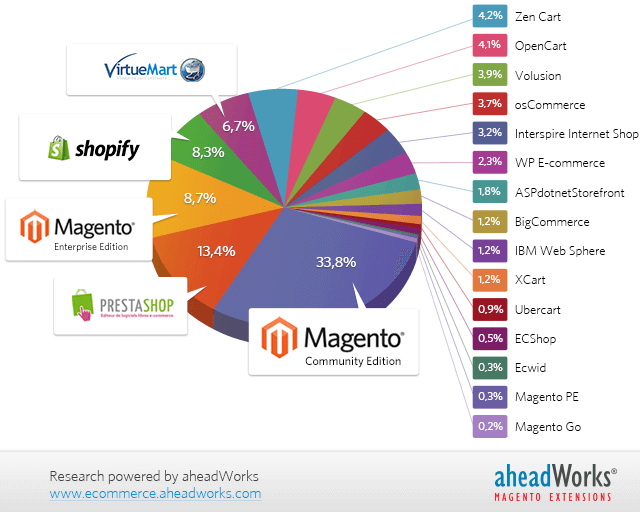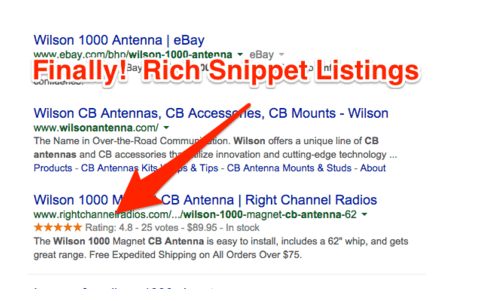Shopify vs. Magento: The Ultimate Enterprise Solution Comparison Guide
As we’ve said before: your ecommerce platform choice can make or break your business.
Using the right one is critical to your success. It’s what allows you to scale your operations and grow.
We’ve had some questions lately around what solution provides the best enterprise platform: Magento Enterprise Edition (EE) or Shopify Plus?
Comparing the two most popular enterprise platforms, Shopify and Magento, the latter is the market leader with nearly 8.7% of all large Ecommerce businesses built on it. Shopify’s market share, while lagging behind in static terms at 8.4%, has increased by 124% between 2013 and 2014, with the growth showing no signs of slowing down in the US. (Source)
Looking at the platform market share stats, Magento Enterprise Edition is clearly the market leader for enterprise-level solutions. Though Shopify is listed, it is not differentiated between Shopify and Shopify Plus.

In this article, we’ll compare Magento EE and Shopify Plus so you can decide which platform is best for your specific business. Don’t get lost in the functions of each technology, but know what it can do for you. Here are 6 points of comparison to give you a foundation for making the best platform decision for your ecommerce company:
1. Shipping Provider Integrations
Your ecommerce tech platform should integrate seamlessly with your shipping provider so your customers can see the most current shipping rates and your products get shipped efficiently. If you’re switching or migrating to another tech platform, it would be ideal for the new platform to sync with your shipping provider’s order processing platform, so you don’t need to reinvent the wheel to display accurate prices on your site.

Using apps like Shipworks, Magento Enterprise (both 1 & 2) integrates with most major shipping providers, including Fedex, USPS, UPS and DHL.
Shopify Plus integrates with USPS, UPS and Fedex as default options, but does not integrate with DHL.
There are apps that do allow you to get DHL rates in your shopping cart – unfortunately for us it would mean changing who we use for shipping and fulfilling orders. Not the end of the world – but not a project we were ready to tackle at the same time. Since we didn’t want to change. I had to manually build out hundreds of custom shipping rates and options for different shipping zones. No way to import them, so I had to do it all by hand. – William Harris, VP Marketing Dollar Hobbyz
Make sure you have clearly outlined the providers you must integrate with before choosing a solution. Missing the mark on this integration could be a frustrating and costly oversight.
2. Security
With more than 30,000 sites being hacked everyday, safeguarding your website and customer data is of utmost importance to running an ecommerce business. The last thing you want is your customer’s details getting stolen and putting your brand at risk.
For this reason, the tech platform you use should be able to encrypt data, be protected with firewalls and antivirus software, regularly monitor and test networks and maintain an information security policy. Your ecommerce website is only as secure as it’s weakest link, so you want to make sure all the ‘links’ in the chain are strong.
Magento Enterprise is traditionally a ‘self-hosted’ platform, which means you have the additional responsibility of ensuring that the data on your hosting provider’s server is secure. This involves additional time and money to be invested, and also transfers the risks of security breaches entirely onto you, the merchant.
Although Magento EE does ensure you’re PCI compliant (a measure to ensure you’re securing customer data) by offering integrated payment gateways. These gateways transmit payment information without actually retaining any data on the Magento application server (source), which prevents the risk of credit card fraud and other payment data related issues, mainly at checkout.
On the other hand, Shopify Plus has more advantages for maintaining security. All Shopify Stores now use SSL encryption (source) everywhere on the site, not just at checkout (which is where it was earlier used). Shopify Plus takes care of hosting for you, and being Level 1 PCI DSS compliant, it basically means all your data is protected with the same level of security provided by a bank (source).
Every page on your Shopify Plus store is protected with SSL encryption, depicted by a ‘lock’ sign in the corner of the address toolbar (see image below), which helps with winning consumer trust and also boosts your rankings on google. Encryption ensures no data is transferred in it’s original form to other platforms without permissions.

Clearly, Shopify Plus can help you get started faster, in a safer environment compared to Magento, unless you make additional investments in Magento to customise security requirements to suit your needs and have the willingness to take the risks associated with being responsible for security breaches.
Related: Don’t Get Hacked! 4 Steps to Secure Your Ecommerce Site
3. SEO Optimization
44% of all ecommerce purchases beginning with an online search!
You must make sure you choose an ecommerce platform that best supports SEO optimization, by integrating well with search engines and helping with displaying search relevant pages on your site to your consumers.
If your platform does not give you control over the “SEO aspects” of your ecommerce store, it can make SEO a painstaking process. For instance, most platforms automatically generate product pages, page titles etc. once you add products to your portfolio. This means automatically generated text, which may not be relevant to your customers’ searches online. You need to be able customise and tweak these aspects, in order to remain relevant to customer searches.
Both platforms permit the use of independent links, page titles, Page URL’s, meta descriptions, image alt tags, H1 Headings, allowing you to customize the text to what your customers are actually searching for, helping you boost search engine rankings. They also offer you the ability to have an integrated blog, social sharing buttons and use of your own domain name, which are critical to SEO optimization. (Source)
The one major benefit Shopify Plus offers is if you’re migrating platforms, you’re able to use the “Traffic Control App” to redirect traffic you’ve built on your previous platform, without compromising on SEO rankings. This can be a lifesaver for your ecommerce business, as you’d normally lose some of your organic traffic when migrating to a platform like Magento.
Some ecommerce companies have reported major increases in sales by migrating from Magento Enterprise to Shopify Plus and using it in combination with a product review service called ‘YOTPO’. This creates ‘rich snippet listings’ in search engine results (like the one below) which boosts click through rates and search engine rankings.
[We’ve seen a] higher click through rate due to the increased number of rich snippets listings @youderian
The main improvements on the Magento 2 platform include:
- (1) the ability to add rich snippets and organize structure markup data,
- (2) The ability to optimize search engine indexation by editing robots.txt files from the admin panel and
- (3) a more extensive set of tools for optimizing category pages. (Source) All of these improvements to the newest version of Magento can help you optimize your store’s search performance.
4. Marketer-Friendly
It’s important for your marketing team to be able to use your ecommerce platform with ease. Given that most marketers come from a non-tech background, the easier the platform is to use, the more likely it is that marketers will optimize the results from their efforts.
Your platform needs to make it easy to execute tasks like creating product descriptions, website copy, customer forms, etc., which help in attracting and engaging your audience, and eventually boosting sales.
Shopify Plus is definitely the most marketer-friendly, giving you leverage over key marketing functions via the admin panel. For instance, it allows you to create ‘conversion pixels’ as a marketer, which enable you to track the success of your social media campaigns. Other benefits include:
- (1) advanced ecommerce analytics giving marketers deep insights on how the site is performing,
- (2) a discount code coupon engine empowering your team to promote products using discounts codes,
- (3) free google adwords credits and
- (4) Marketers can use apps like Klaviyo and Rare.io to integrate the platform with targeted email marketing campaigns using Aweber or Mailchimp (Source).
Magento does not have the default functionality of creating conversion pixels to track campaigns. Instead, a developer must create them. This can make marketers dependent on developers, which can be very time consuming. It also does not allow marketers to customize the appearance of the website as quickly in order to A/B test campaigns or pages. No social media features are included by default, but you can integrate just about any social media app. A unique feature on the Magento platform is the built-in newsletter subscription management tool which also integrates with coupon codes (source), although most users opt for a platform like Mailchimp or Infusionsoft to do this.
Magento 2 is certainly an improved version, giving marketers the benefit of faster page load times and a friendlier backend UI, all of which enhance the customer experience. This version also allows marketers to use referral and affiliate marketing extensions, that help drive more traffic to your site leading to more sales. Clearly, there are significant improvements compared to the first version.
5. B2B Support
Shopify Plus supports B2B (or wholesale) functionality via a B2B wholesale app. There are a few ways you can offer your products at wholesale prices, which include starting a new “B2B Wholesale” store and offering B2B discounts on retail prices with coupon codes. With the help of a Wholesale App, you can offer different customers different prices, keeping retail and whole parts of your ecommerce business separate. Another option is to restrict access to your wholesale store depending on the customer account. This way, only wholesale customers can access your B2B store through their customer account. (Source)
Given that B2B sales is more complex than B2C, Magento makes an attempt to ‘consumerize B2B sales’ while still supporting all of it’s complexities. It supports negotiated pricing terms (i.e. different prices for different buyers), faster bulk orders, and complex payment terms, all of which are essential to B2B ecommerce success. (source)
Although Shopify Plus supports B2B ecommerce, it does this through ‘add-on’ apps in addition to the original version, adding to the costs of using the platform. Both Magento 1 and 2, on the other hand, offer greater customizability and support greater complexities of B2B ecommerce, making it a better choice.
6. Ecosystem & Support
Choosing a platform with a well established ecosystem of third party providers and supporters goes a long way to ensure you’re well looked after when things get rough with technology.
The Magento ecommerce platform serves more than 200,000 merchants around the world and is supported by a global community of solution partners, merchants, forum moderators and developers (Source). It has online forums where the entire community supports each other with any questions they may have and also holds ‘meetup’ groups for anyone affiliated with the platform. Clearly, the amount of support is enormous, and you’ll never be left in the dark.
There is only one concern that does cause some anxiety in the Magento community: the development of the Magento platform. Magento 2 was recently released, and though there are major benefits, many feel the release was too drawn-out and that the new version is actually not a viable upgrade from previous Magento versions. You can read more on that here: “Is Magento Dead? The Pros & Cons of Magento 2“.
Shopify now serves more than 150,000 merchants in over 150 countries. (We’re unsure of the breakdown between Shopify and Shopify Plus.) It makes it really easy to download and run third party applications, which makes Shopify Plus an attractive option for developers as well as merchants. Having grown rapidly in market share since Shopify went public, Shopify Plus is definitely the more cost effective option, with the plethora of third party apps available in the ecosystem.
So which one should you choose?
Both Shopify Plus and Magento Enterprise offer great benefits to ecommerce business owners. If you’ve got the resources to invest in development of a highly sophisticated ecommerce platform, or if you deal in complex B2B ecommerce transactions, Magento Enterprise may be the way to go.
If on the other hand, you’re looking to launch faster, have an openness to utilizing third party applications and prefer a more user-friendly user interface, Shopify Plus is the better option. Your decision depends on your company’s unique circumstances and overall business goals.






